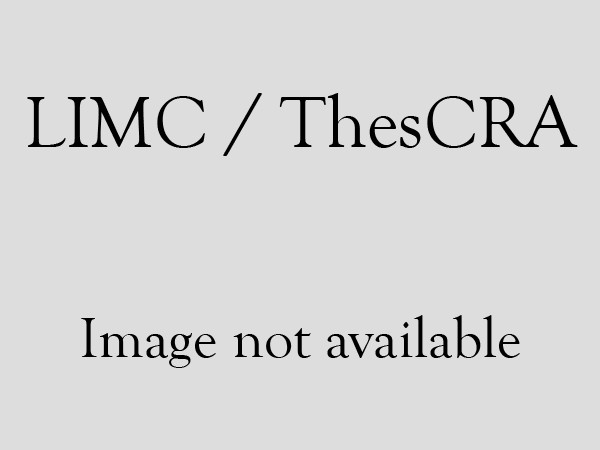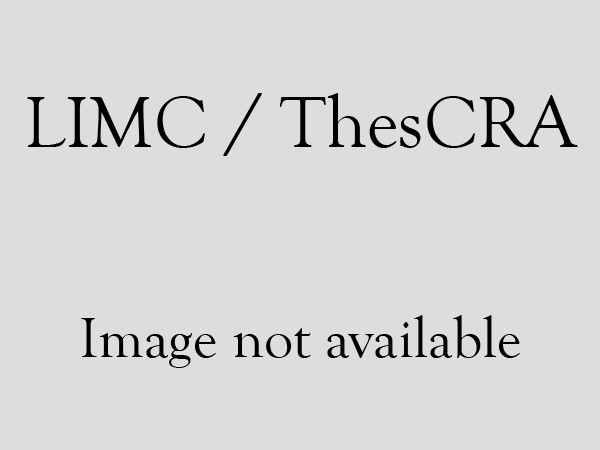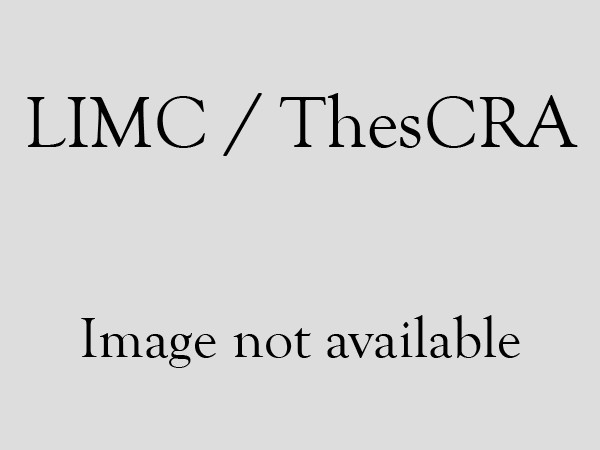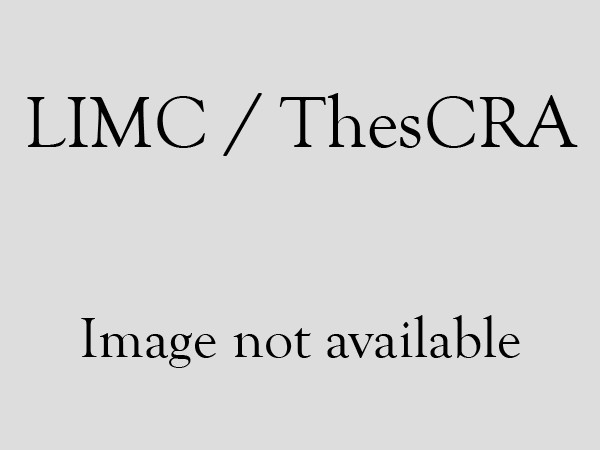
Keywords: MID54029, SMID59442, V. 2.b. Kultinstrumente 1223, hethmos, varia, bronze, 100/150, Mauer an der Url (Lauriacum), Austria, Wien, Kunsthistorisches Museum, M 30

Keywords: MID54030, SMID59443, V. 2.b. Kultinstrumente 1223, hethmos, varia, bronze, 240/260, Mauer an der Url (Lauriacum), Austria, Wien, Kunsthistorisches Museum, M 38. 39

Keywords: MID38150, SMID40121, Aphrodite 218, hydria, vase painting, red figured, Apulia, terracotta, B. M. F 336, -350/-325, Collections privées, Collection A. Dechter, RVAp I 375, 121, wreath, crown, stephane, corona, mirror, pillar, naiskos, aedicula, Aphrodite

Keywords: Auf dem felsigen Plateau nördlich unterhalb der Akropolis verteilen sich über ein Areal von ca. 130 x 130 m etwa 40 Felsabarbeitungen Schrammen, J., Der grosse Altar, in: Pergamon III, 1 (1896) 7–90; Brückner, A., Wann ist der Altar von Pergamon errichtet worden?, AA (1904) 218–224; Napp, A.E. (Hrsg.), Der Altar von Pergamon (1936); Bruns, G., Der grosse Altar von Pergamon (1949); Bruns 101–111; Rohde, E. (Hrsg.), Pergamon. Burgberg und Altar (1961); Schmidt, E., Der grosse Altar zu Pergamon (1961); Simon, Pergamon und Hesiod (1975); Stähler, K., Untersuchungen zur architektonischen Gestalt des Pergamonaltars, in: Studien zur Religion und Kultur Kleinasiens. (Festschrift für F.K. Dörner) (1978) 838–867; Callaghan, P.J., On the date of the Great Altar of Zeus at Pergamon, BICS 28 (1981) 115–121; Schalles, H.J., Der Pergamonaltar. Zwischen Bewertung und Verwertbarkeit (1986); Hoepfner, W., Zu den grossen Altären von Magnesia und Pergamon, AA (1989) 601–634 (= Hoepfner 1); Andreae, B. (Hrsg.), Phyromachos-Probleme. Mit einem Anhang zur Datierung des Grossen Altars von Pergamon (1990); Börker, C., Zur Datierung des Pergamon-Altars, in: Akten des 13. Internationalen Kongresses für Klassische Archäologie Berlin 1988 (1990) 591–592; Kunze, M./Kästner, V. (Hrsg.), Der Altar von Pergamon, hellenistische und römische Architektur (21990); Kunze, M., Neue Forschungen zum Pergamonaltar, in: Etienne/Le Dinahet, L’espace sacrificiel 135–140 (Kunze 1); Hoepfner, Bauliche Details am Pergamonaltar, AA (1991) 189–202 (= Hoepfner 2); id., Siegestempel und Siegesaltäre. Der Pergamonaltar als Siegesmonument, in: Hoepfner, W./Zimmer, G. (Hrsg.), Die griechische Polis. Architektur und Politik (1993) 111–125 (= Hoepfner 3); Kästner, V., Gigantennamen, IstanbMitt 44 (1994) 125–134 (= Kaestner 1); Gates, M.H., Archaeology in Turkey, AJA 100 (1996) 322–324; Kunze, Parthenon und Pergamonaltar. Das Bildprogramm am Pergamonaltar als Rückgriff auf den Parthenon?, Thetis 3 (1996) 71–80 (= Kunze 2); Hoepfner, Der vollendete Pergamonaltar, AA (1996) 115–134 (= Hoepfner 4); id., Zum Pergamon-Altar, Anadolou Anatolia 23 (1984–1997) 187–193 (= Hoepfner 5); Seiterle, Rückgabe des Zeusaltars – an Athena, AntW 28 (1997) 201–208; Heilmeyer, W.D., Der Pergamonaltar. Die neue Präsentation nach der Restaurierung des Telephosfrieses (1997); Kästner, The architecture of the Great Altar of Pergamon, in: Pergamon. Citadel of the goda. Archaeological record, literary description, and religious development (1998) 137–161 (= Kästner 2); Webb, P.A., The Functions of the Sanctuary of Athena and the Pergamon Altar (the Heroon of Telephos) in the Attalid Building Programm, in: Stephanos (Festschrift B.S. Ridgway) (1998) 244–254; Radt, Pergamon, Geschichte und Bauten einer antiken Metropole (1999) 168–180; De Luca, G./Radt, Sondagen im Fundament des grossen Altars. Pergamenische Forschungen 12 (1999); Kästner, Vorläufiger Bericht zu den Ergebnissen der Untersuchungen am Oberbau des Pergamonaltars, in: Bericht über die 40. Tagung für Ausgrabungswissenschaft und Bauforschung (Kongress Wien 1998) (2000) 64–78 (= Kästner 3); Stewart, Pergamo ara marmorea magna. On the date, altar, MID53203, SMID58562 – LIMC/ThesCRA: -175/-150

Keywords: MID203132, SMID100170, B. M., urn, sculpture in the round, Roman, röm. 16, Italy, Altino, Museo Archeologico Nazionale d’Altino, Kolloquium Rom 1998 (2001) 243-256 fig.3; Scarfi

Keywords: MID10965, SMID11213, Aithra I 56, Diomedes I 66, Helene 200, Kassandra I (vol. VII) 43, IV. 1.b. Kultorte (Darstellungen) 134, wall painting, Roman, -15/63, Pompei I 2.6, Raum m, Italy, Napoli, Museo Archeologico Nazionale, 109751, altar, base, tree, tripod, garland, column, table, mensa, trapeza, Palladion, temple, amphora, sacral-idyllic landscape, altar with protection against wind, altar: monolithic block, Aithra I, Diomedes I, Helene, Kassandra I, Odysseus

Keywords: MID10965, SMID11213, Aithra I 56, Diomedes I 66, Helene 200, Kassandra I (vol. VII) 43, IV. 1.b. Kultorte (Darstellungen) 134, wall painting, Roman, -15/63, Pompei I 2.6, Raum m, Italy, Napoli, Museo Archeologico Nazionale, 109751, altar, base, tree, tripod, garland, column, table, mensa, trapeza, Palladion, temple, amphora, sacral-idyllic landscape, altar with protection against wind, altar: monolithic block, Aithra I, Diomedes I, Helene, Kassandra I, Odysseus

Keywords: MID9329, SMID15175, f, Eros/Amor, Cupido 289, Machaireus 2, Neoptolemos 26, IV. 1.b. Kultorte (Darstellungen) 55a, wall painting, Roman, 45/79, Pompei V 4.11 (House of M. Lucretius Fronto)- Description (detail): Neoptolemos sur un autel est attaqué par Orestes et un jeune homme; une prêtresse est tombée à terre au milieu d’objets épars, écrasant la table sur laquelle ils étaient vraisemblablement posés. Derrière le groupe central de personnages, un taureau blanc, l’animal que l’on s’apprêtait à sacrifier. A l’arrière plan, façade de temple., Italy, Pompei, V 4.11, Casa di M. Lucretius Fronto, altar, phiale, phiale mesomphalos, patera, sword, oinochoe, tympanon (tambourine), table, mensa, trapeza, temple, spear, bull, bukranion, sacrificial animal, altar: monolithic block, pediment, architrave, Neoptolemos, Orestes

Keywords: MID9329, SMID15175, f, Eros/Amor, Cupido 289, Machaireus 2, Neoptolemos 26, IV. 1.b. Kultorte (Darstellungen) 55a, wall painting, Roman, 45/79, Pompei V 4.11 (House of M. Lucretius Fronto)- Description (detail): Neoptolemos sur un autel est attaqué par Orestes et un jeune homme; une prêtresse est tombée à terre au milieu d’objets épars, écrasant la table sur laquelle ils étaient vraisemblablement posés. Derrière le groupe central de personnages, un taureau blanc, l’animal que l’on s’apprêtait à sacrifier. A l’arrière plan, façade de temple., Italy, Pompei, V 4.11, Casa di M. Lucretius Fronto, altar, phiale, phiale mesomphalos, patera, sword, oinochoe, tympanon (tambourine), table, mensa, trapeza, temple, spear, bull, bukranion, sacrificial animal, altar: monolithic block, pediment, architrave, Neoptolemos, Orestes

Keywords: MID477, SMID273, Ares/Mars 357, Eros/Amor, Cupido 331, Cupido 608ad, Hymenaios 8, Lupa Romana 15, Palatinus 2, Tiberis, Tiberinus 7, I. 2.d. Weihgeschenke röm 501, IV. 1.a. Kultorte etr ital. röm. 30, altar, relief, Roman, marble, 100/110, Ostia – Dimensions: H 1.10 m; B=T 0.82–0.88 m, Italy, Roma, Museo Nazionale Romano, 324

Keywords: MID477, SMID273, Ares/Mars 357, Eros/Amor, Cupido 331, Cupido 608ad, Hymenaios 8, Lupa Romana 15, Palatinus 2, Tiberis, Tiberinus 7, I. 2.d. Weihgeschenke röm 501, IV. 1.a. Kultorte etr ital. röm. 30, altar, relief, Roman, marble, 100/110, Ostia – Dimensions: H 1.10 m; B=T 0.82–0.88 m, Italy, Roma, Museo Nazionale Romano, 324

Keywords: MID477, SMID273, Ares/Mars 357, Eros/Amor, Cupido 331, Cupido 608ad, Hymenaios 8, Lupa Romana 15, Palatinus 2, Tiberis, Tiberinus 7, I. 2.d. Weihgeschenke röm 501, IV. 1.a. Kultorte etr ital. röm. 30, altar, relief, Roman, marble, 100/110, Ostia – Dimensions: H 1.10 m; B=T 0.82–0.88 m, Italy, Roma, Museo Nazionale Romano, 324

Keywords: MID52865, SMID58195, V. 2.b. Kultinstrumente 963a, relief, Africa, marble, 100/200, Sousse (Hadrumetum), Tunisia, Musée Archéologique, M XIX Ro. 189, sceptre, rudder, oar, horn, horns, Triton, musical instruments, war-chariot, harma, currus, gesture: one forearm raised (worship, prayer, greeting?), captive, triumph

Keywords: MID53835, SMID59233, V. 2.b. Kultinstrumente 518, arula, varia, terracotta, -500/-490, United States, Cambridge (Massachusetts), Harvard University Art Museums, Arthur M. Sackler Museum, 1960.491, gesture of aposkopein, satyr, silen, altar: arula, portable altar